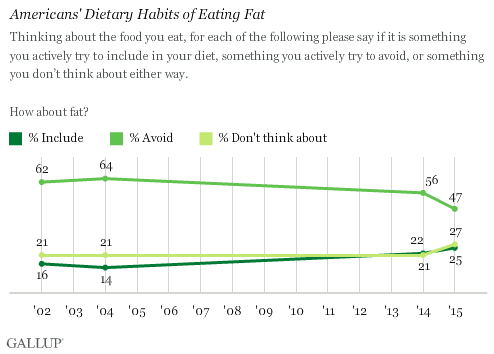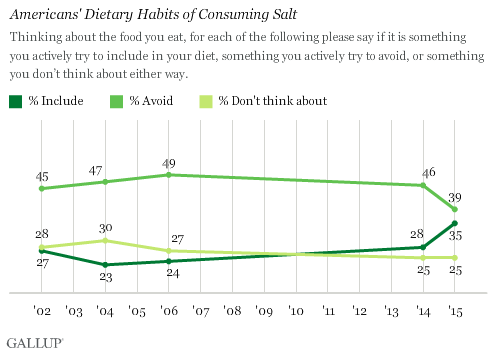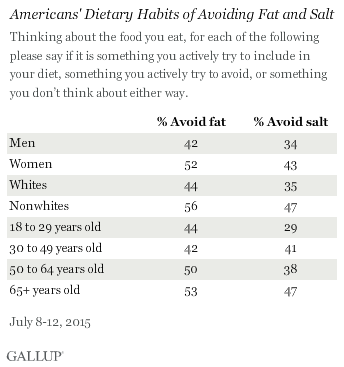Story Highlights
- Fewer people avoiding fat, more including it in diet
- Americans equally as likely to avoid salt as to include it
WASHINGTON, D.C. -- Several recent reports have suggested that fat is not the nutritional hazard it was once presumed to be. This perhaps helps explain why the 47% of Americans who say they "actively try to avoid" consuming it is the lowest level Gallup has measured since it first asked this question in 2002. Conversely, a quarter of Americans say they try to include fat in their diet, while about the same percentage claim they don't think about it.

These results are from the Gallup Consumption Habits survey, conducted July 8-12, about a month after news that the federal government's updated Dietary Guidelines for Americans, to be issued later this year, will no longer feature upper limits on total fat intake. The government's Dietary Guidelines Advisory Committee found no health benefit to limiting the amount of total fat in one's diet, whereas past editions of the federal guidelines had suggested limits. The committee did maintain, however, that saturated fat should be limited because doing so could lower the risk of heart disease.
Gallup polling more than a decade ago found more than six in 10 Americans saying they avoid fat in their diet. This dropped to 56% last year, and to less than a majority this year. The one in four Americans who now say they try to include fat in their diet is up from about one in six in the early 2000s.
More Americans Passing the Salt
Americans' attitudes about consuming salt show a similar pattern, with the percentage saying they avoid salt in their diet falling to 39% this year from 46% a year ago. Nearly as many Americans now say they actively try to include salt in their diet (35%) as say they actively try to exclude it.

But while government research data may support a retreat from limits on fat intake, that isn't the case for salt -- at least for now. There is growing agreement within the nutrition science community that salt is not as harmful to one's health as Americans have been led to believe. Despite this debate, a recent survey by the U.S. Centers for Disease Control and Prevention found that nine in 10 Americans consume too much salt, which increases their risk of hypertension, stroke and heart disease.
Underscoring the difference between Americans' nutritional attitudes and sometimes-conflicting medical evidence, more Americans still say they try to avoid fat than say they avoid salt, and this holds up among all major demographic groups.

Bottom Line
Americans' diets, like the health recommendations for them, are constantly evolving, likely influenced over time by scientific research as well as fad diets.
This seems to be the case with fat, which, according to the Dietary Guidelines Advisory Committee, is not something Americans need to limit, as they may have heard they should do in the past -- at least in terms of total fat intake.
While scientific input can significantly influence what Americans eat, that doesn't mean Americans always take the advice. In the case of salt, which continues to be a health risk when consumed in excess, Americans appear to have eased their self-restraint, despite contrary advice from government health organizations.
Survey Methods
Results for this Gallup poll are based on telephone interviews conducted July 8-12, 2015, on the Gallup U.S. Daily survey, with a random sample of 1,009 adults, aged 18 and older, living in all 50 U.S. states and the District of Columbia. For results based on the total sample of national adults, the margin of sampling error is ±4 percentage points at the 95% confidence level. All reported margins of sampling error include computed design effects for weighting.
Each sample of national adults includes a minimum quota of 50% cellphone respondents and 50% landline respondents, with additional minimum quotas by time zone within region. Landline and cellular telephone numbers are selected using random-digit-dial methods.
Learn more about how Gallup Poll Social Series works.

